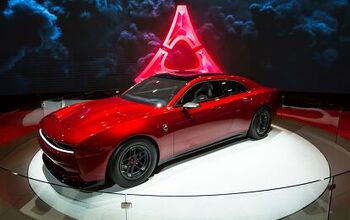Rare Rides: A 2017 Gillet Vertigo - The Best a Man Can Get?

In what may be a Rare Rides first, today’s featured coupe is sporty, aggressive, and completely off the map. Don’t bother searching TTAC for Gillet, because there are zero results. Let’s learn a bit more about whatever this is, as it’s surely very good.
Not to be confused with the razor blade company, this Gillet was the creation of a Belgian company founded by retired race car driver Tony Gillet. Since 1992, Gillet has built hand-made cars using carbon fiber construction.
Mr. Gillet got his start doing things like hill-climb events and the Paris Dakar rally. In the early Eighties he branched out into automobile importation, becoming the official Belgian importer for Donkervoort. Based in the Netherlands, Donkervoort has produced hand-built lightweight sports cars in the style of Caterham since 1978. But that’s another Rare Rides; today we’ve got Vertigo.
The first Vertigo was a cross between the Donkervoort and a Caterham, and Gillet had it in prototype form in early 1992. Finalized in its design thereafter, a production version was shown around the glitzy Euro car show circuit in 1993. The first production car was built in 1993 or 1994 and was used for crash testing and certification.
The Vertigo also went racing between 1998 and 2008, though it’s unclear exactly how many original Vertigo racing and passenger examples exist.
Along the way, the Vertigo added power. Initially it used a Ford Cosworth 2.0-liter mill, but switched after a few years to a 3.0L Alfa Romeo V6. A revised Vertigo .5 (and a half?) debuted at the Brussels auto show in 2008, bringing us to the current version.
With a considerably less Caterham-like exterior, the modern Vertigo features a lightweight carbon fiber body and an Alfa Romeo V6. When it started life, said engine was a 3.6-liter, but was reworked by the engineers at Gillet to 3.9 liters in displacement. The transmission is manual, and the interior errs on the workshop side of basic. The front is very long; the rear deck very short.
Gillet still exists today, and has a current website and a factory location. Take this one to your local voiture et café for $209,000.
[Images: seller]

Interested in lots of cars and their various historical contexts. Started writing articles for TTAC in late 2016, when my first posts were QOTDs. From there I started a few new series like Rare Rides, Buy/Drive/Burn, Abandoned History, and most recently Rare Rides Icons. Operating from a home base in Cincinnati, Ohio, a relative auto journalist dead zone. Many of my articles are prompted by something I'll see on social media that sparks my interest and causes me to research. Finding articles and information from the early days of the internet and beyond that covers the little details lost to time: trim packages, color and wheel choices, interior fabrics. Beyond those, I'm fascinated by automotive industry experiments, both failures and successes. Lately I've taken an interest in AI, and generating "what if" type images for car models long dead. Reincarnating a modern Toyota Paseo, Lincoln Mark IX, or Isuzu Trooper through a text prompt is fun. Fun to post them on Twitter too, and watch people overreact. To that end, the social media I use most is Twitter, @CoreyLewis86. I also contribute pieces for Forbes Wheels and Forbes Home.
More by Corey Lewis
Latest Car Reviews
Read moreLatest Product Reviews
Read moreRecent Comments
- Jeff Self driving cars are not ready for prime time.
- Lichtronamo Watch as the non-us based automakers shift more production to Mexico in the future.
- 28-Cars-Later " Electrek recently dug around in Tesla’s online parts catalog and found that the windshield costs a whopping $1,900 to replace.To be fair, that’s around what a Mercedes S-Class or Rivian windshield costs, but the Tesla’s glass is unique because of its shape. It’s also worth noting that most insurance plans have glass replacement options that can make the repair a low- or zero-cost issue. "Now I understand why my insurance is so high despite no claims for years and about 7,500 annual miles between three cars.
- AMcA My theory is that that when the Big 3 gave away the store to the UAW in the last contract, there was a side deal in which the UAW promised to go after the non-organized transplant plants. Even the UAW understands that if the wage differential gets too high it's gonna kill the golden goose.
- MKizzy Why else does range matter? Because in the EV advocate's dream scenario of a post-ICE future, the average multi-car household will find itself with more EVs in their garages and driveways than places to plug them in or the capacity to charge then all at once without significant electrical upgrades. Unless each vehicle has enough range to allow for multiple days without plugging in, fighting over charging access in multi-EV households will be right up there with finances for causes of domestic strife.








































Comments
Join the conversation
I'm sure it sounds great with that Alfa V6. As a bonus, if it drives away to show off the sound, I won't have to look at it.
I produce electronic music. Sometimes you'll work on a track and keep working and working and reworking, and you start out with good ideas, but you get ear-blind and just expand and extend and distort them without realizing it. So you end up with something that you think is just amazing, because it took these basically good ideas but you've gotten used to this gradual but huge extension and distortion of them until it's totally unlistenable to anyone else. I feel like something similar may have happened here.